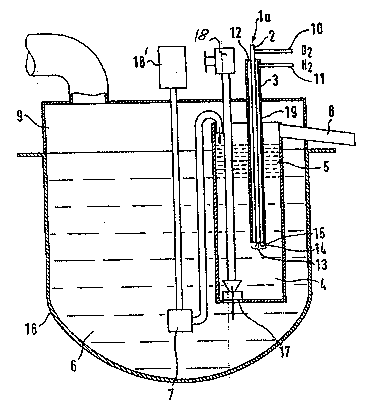Une partie des informations de ce site Web a été fournie par des sources externes. Le gouvernement du Canada n'assume aucune responsabilité concernant la précision, l'actualité ou la fiabilité des informations fournies par les sources externes. Les utilisateurs qui désirent employer cette information devraient consulter directement la source des informations. Le contenu fourni par les sources externes n'est pas assujetti aux exigences sur les langues officielles, la protection des renseignements personnels et l'accessibilité.
L'apparition de différences dans le texte et l'image des Revendications et de l'Abrégé dépend du moment auquel le document est publié. Les textes des Revendications et de l'Abrégé sont affichés :
| (12) Demande de brevet: | (11) CA 2127674 |
|---|---|
| (54) Titre français: | PROCEDE D'EXTRACTION DE L'ETAIN, DE L'ARSENIC ET DE L'ANTIMOINE PRESENTS DANS DU PLOMB FONDU |
| (54) Titre anglais: | PROCESS FOR REMOVING TIN, ARSENIC AND ANTIMONY FROM MOLTEN LEAD |
| Statut: | Réputée abandonnée et au-delà du délai pour le rétablissement - en attente de la réponse à l’avis de communication rejetée |
| (51) Classification internationale des brevets (CIB): |
|
|---|---|
| (72) Inventeurs : |
|
| (73) Titulaires : |
|
| (71) Demandeurs : |
|
| (74) Agent: | BORDEN LADNER GERVAIS LLP |
| (74) Co-agent: | |
| (45) Délivré: | |
| (22) Date de dépôt: | 1994-07-08 |
| (41) Mise à la disponibilité du public: | 1995-01-09 |
| Requête d'examen: | 1998-03-12 |
| Licence disponible: | S.O. |
| Cédé au domaine public: | S.O. |
| (25) Langue des documents déposés: | Anglais |
| Traité de coopération en matière de brevets (PCT): | Non |
|---|
| (30) Données de priorité de la demande: | ||||||
|---|---|---|---|---|---|---|
|
Abstract of the Disclosure
The invention relates to a process for removing tin,
arsenic and antimony from molten lead by means of oxygen
or oxygen-containing gas mixtures, which is or are blown
into the molten lead by means of at least one gas
nozzle. To avoid damage to the gas nozzle, at least the
oxygen outlet region thereof, located in the molten lead
is enveloped by an inert gas.
Note : Les revendications sont présentées dans la langue officielle dans laquelle elles ont été soumises.
Note : Les descriptions sont présentées dans la langue officielle dans laquelle elles ont été soumises.

2024-08-01 : Dans le cadre de la transition vers les Brevets de nouvelle génération (BNG), la base de données sur les brevets canadiens (BDBC) contient désormais un Historique d'événement plus détaillé, qui reproduit le Journal des événements de notre nouvelle solution interne.
Veuillez noter que les événements débutant par « Inactive : » se réfèrent à des événements qui ne sont plus utilisés dans notre nouvelle solution interne.
Pour une meilleure compréhension de l'état de la demande ou brevet qui figure sur cette page, la rubrique Mise en garde , et les descriptions de Brevet , Historique d'événement , Taxes périodiques et Historique des paiements devraient être consultées.
| Description | Date |
|---|---|
| Inactive : CIB de MCD | 2006-03-11 |
| Demande non rétablie avant l'échéance | 2000-07-10 |
| Le délai pour l'annulation est expiré | 2000-07-10 |
| Réputée abandonnée - omission de répondre à un avis sur les taxes pour le maintien en état | 1999-07-08 |
| Inactive : Renseign. sur l'état - Complets dès date d'ent. journ. | 1998-03-25 |
| Inactive : Dem. traitée sur TS dès date d'ent. journal | 1998-03-25 |
| Lettre envoyée | 1998-03-25 |
| Exigences pour une requête d'examen - jugée conforme | 1998-03-12 |
| Toutes les exigences pour l'examen - jugée conforme | 1998-03-12 |
| Toutes les exigences pour l'examen - jugée conforme | 1998-01-13 |
| Demande publiée (accessible au public) | 1995-01-09 |
| Date d'abandonnement | Raison | Date de rétablissement |
|---|---|---|
| 1999-07-08 |
Le dernier paiement a été reçu le 1998-06-16
Avis : Si le paiement en totalité n'a pas été reçu au plus tard à la date indiquée, une taxe supplémentaire peut être imposée, soit une des taxes suivantes :
Veuillez vous référer à la page web des taxes sur les brevets de l'OPIC pour voir tous les montants actuels des taxes.
| Type de taxes | Anniversaire | Échéance | Date payée |
|---|---|---|---|
| TM (demande, 3e anniv.) - générale | 03 | 1997-07-08 | 1997-06-23 |
| Requête d'examen - générale | 1998-03-12 | ||
| TM (demande, 4e anniv.) - générale | 04 | 1998-07-08 | 1998-06-16 |
Les titulaires actuels et antérieures au dossier sont affichés en ordre alphabétique.
| Titulaires actuels au dossier |
|---|
| MESSER GRIESHEIM GMBH |
| Titulaires antérieures au dossier |
|---|
| DIETMAR WIECK |
| FRANK TOUBARTZ |
| GERHARD GROSS |
| KARL HENGST |